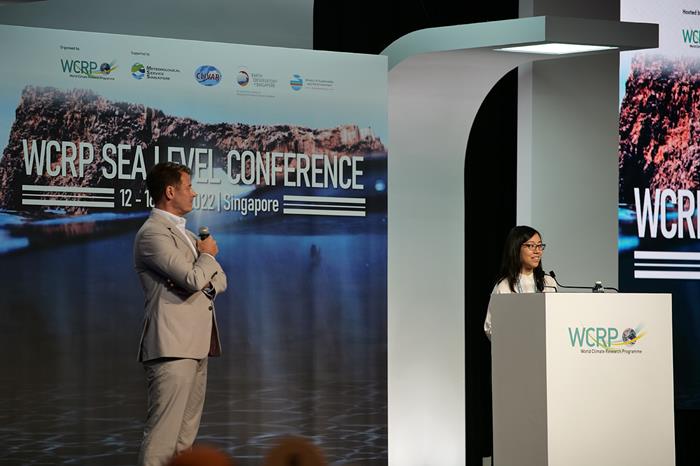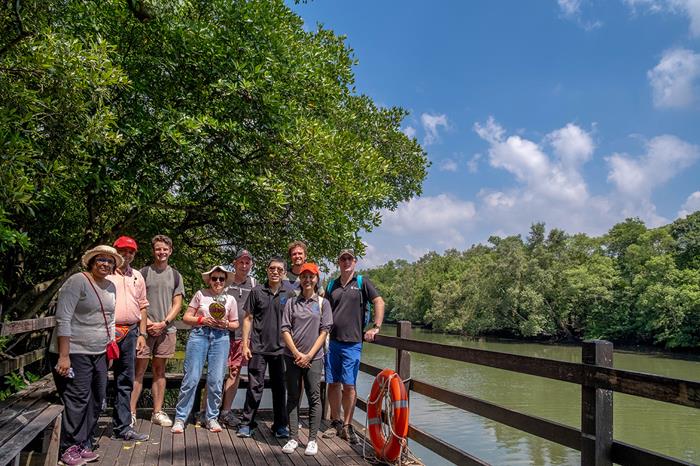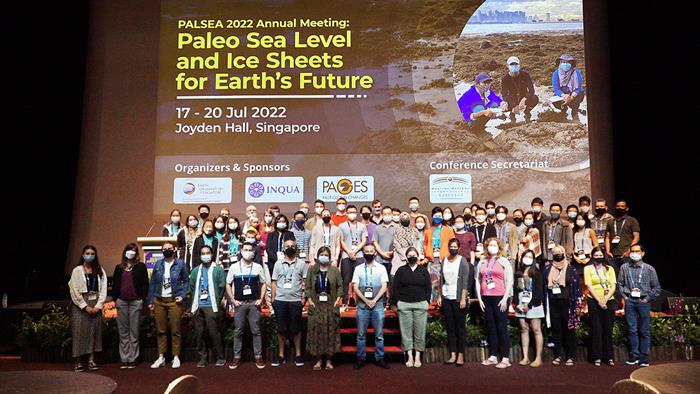With sea-level rise threatening many low-lying nations like Singapore, the Earth Observatory of Singapore (EOS) co-hosted two conferences to gather international scientists and practitioners to advance sea-level science, improve models and projections, and bridge the gap between science and its benefits to societies.
The World Climate Research Programme (WCRP) conference 2022 took place between 12 and 16 July, in Singapore and online. Hundreds of attendees, scientists and practitioners alike, gathered from around the world to present their latest work. The conference kicked off with an address from Ms Grace Fu, Singapore’s Minister for Sustainability and the Environment. A series of invited talks followed, including one from Professor Benjamin Horton, Director of the Earth Observatory of Singapore.

Singapore’s Minister for Sustainability and the Environment Grace Fu gave an opening address at the World Climate Research Programme conference (Source: Spark Planners)
Prof Horton provided an overview of sea-level research in Southeast Asia, touching on the complexity of sea-level science and of making projections due to a range of local, regional, and global processes driving sea-level rise. He shared how his EOS team is looking at proxies from the region, including Singapore, and the importance of extending those back in time to improve models and projections. He also highlighted how rates of sea-level changes drive the evolution of coastal landscapes and large human migrations, stressing the fact that mangroves and other ecosystems cannot sustain the high rates of sea-level rise predicted under high-emission scenarios. Even though reducing our emissions today will have little effect on sea-level rise by 2050, it will have profound impacts on sea-level rise thereafter, Prof Horton said.
Many young EOS scientists also took the stage to present their work. Research Fellow Stephen Chua explained how he extended the Singapore’s sea-level record to 10,000 years ago, PhD student Cheryl Tay highlighted rapidly sinking cities worldwide, while another PhD student, Fangyi Tan, showed the use of microatolls to reconstruct Singapore’s sea-level history. The following days saw a succession of talks including those from Research Fellow Jedrzej Majewski and Senior Research Fellow Dhrubajyoti Samanta who presented about using microatolls to reconstruct sea-level records and detecting anthropogenic footprints on sea-level rise, respectively.

PhD candidate Cheryl Tay discussing her research in a session chaired by Professor Benjamin Horton (Source: Spark Planners)
Other scientists presented their work through posters. This includes EOS’s work on sea-level and land-height changes, and extreme events in Singapore and the region. Many of these presentations were related to the EOS SouthEast Asia SEA-level (SEA2) program.
"The WCRP conference was an excellent opportunity for me to engage with different stakeholders, especially ministries and industry representatives, and tt was interesting to have representatives from industries explain how some of my findings could influence their decisions,” said Dr Constance Chua, a Research Fellow from the Coastal Lab research group at EOS. “In some cases, our concepts on the same terminology differed, so the discussions were useful to see how we can advance sea-level research together. Hopefully, this conference have paves the way for different stakeholders to engage in further discussions and collaborations."
Just after the WCRP conference, the PALeo constraints on SEA-level rise (PALSEA) conference began. The four-day-long conference focused on past records of sea-level change and how they help constrain models that are used to make projections. The conference started with a day of field trips around Singapore led by EOS researchers to share their field studies with fellow attendees. One group headed to Pulau Ubin to discover how the Sea-Level Research team is using mangrove sediments to reconstruct sea-level history. In the Southern Islands, the Geology of Earthquakes and Sea Level team showed how they reconstruct past sea level using microatolls. Another group visited the Sungei Buloh Wetland Reserve, where climate scientists from the Coastal Lab showcased Singapore’s rich mangrove ecosystems.

Some of the participants at the Sungei Buloh Wetland Reserve (Source: Felix Galistan/Earth Observatory of Singapore)
The following three days were dedicated to scientific talks, poster sessions, and discussions to advance paleo sea-level science. Assistant Professor Aron Meltzner and Associate Professor Adam Switzer, both Principal Investigators at EOS, jointly led the conference.
“The PALSEA meeting allowed EOS researchers to spotlight the cutting-edge methods we are developing to study sea-level change, and to gain insight from other experts around the world,” said Asst Prof Meltzner. “The meeting also highlighted the need and urgency to focus more sea-level research on tropical areas such as Singapore, where, until recently, little work had been done.”
As the event aimed at fostering the young generation of scientists, many EOS early-career researchers got to share their work. This was a welcome opportunity after more than two years of decreased international interactions due to COVID.

PALSEA conference attendees gathered for a group photo on the final day of the conference (Source: Hadi Ikhsan/Earth Observatory of Singapore)
Senior Research Fellow Tanghua Li presented how he is using Arctic data to constrain the glacial isostatic adjustment model he uses for studying sea-level rise in Singapore. Another Senior Research Fellow, Timothy Shaw, presented a reconstruction of sea-level changes in the region over the last 20,000 years. It included how fast these changes happened, which is crucial for adaptation to rising seas. Research Fellow Jedrzej Majewski showed how he extended the sea-level record in Singapore. PhD student Gina Sarkawi explained how she used some corals from the Philippines to understand sea-level changes and seismic hazard.

Senior Research Fellow Tanghua Li presenting his research (Source: Hadi Ikhsan/Earth Observatory of Singapore)
The poster sessions facilitated further exchanges between attendees, with more than 20 posters from the EOS Coastal Lab, Sea-Level Research, Geology of Earthquakes and Sea Level, and Isotope Geochemistry research teams. Each poster showcased the various proxies, such as microatolls, sediment cores, marine terraces, tide gauges, beach ridges, stalagmites. They also featured novel techniques, including photogrammetry and simulations, that EOS is using to refine the understanding of sea-level variability, land deformation, and past climates in the region.
“These presentations highlighted the breadth and depth of sea-level science done at EOS, that addresses the needs of Singapore so we can better prepare and adapt to future sea-level rise,” said Prof Horton. “I am extremely proud of our young researchers, our problem solvers, who are looking at key challenges we need to address, and who demonstrated such professionalism and expertise in their presentations during both conferences.”